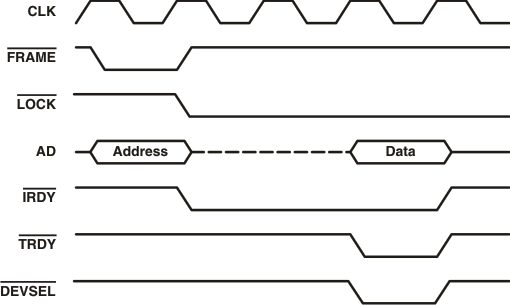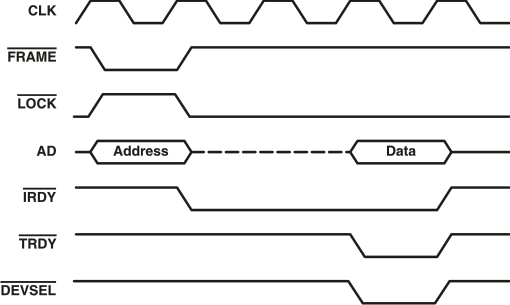ZHCSS37J may 2009 – january 2021 XIO2001
PRODUCTION DATA
- 1
- 1 特性
- 2 应用
- 3 说明
- 4 Revision History
- 5 Pin Configuration and Functions
-
6 Specifications
- 6.1 Absolute Maximum Ratings
- 6.2 Handling Ratings
- 6.3 Recommended Operating Conditions
- 6.4 Thermal Information #GUID-4E9F689A-942D-492C-8F28-F3CC5F1BD0E6/SCPS2129637AN1
- 6.5 Nominal Power Consumption
- 6.6 PCI Express Differential Transmitter Output Ranges
- 6.7 PCI Express Differential Receiver Input Ranges
- 6.8 PCI Express Differential Reference Clock Input Ranges #GUID-60875016-888B-4DD4-A309-543B497BAC9F/SCPS1718455
- 6.9 PCI Bus Electrical Characteristics
- 6.10 3.3-V I/O Electrical Characteristics
- 6.11 PCI Bus Timing Requirements
- 6.12 Power-Up/-Down Sequencing
- 7 Parameter Measurement Information
-
8 Detailed Description
- 8.1 Overview
- 8.2 Functional Block Diagram
- 8.3
Feature Description
- 8.3.1 Bridge Reset Features
- 8.3.2 PCI Express Interface
- 8.3.3 PCI Port Arbitration
- 8.3.4 Configuration Register Translation
- 8.3.5 PCI Interrupt Conversion to PCI Express Messages
- 8.3.6 PME Conversion to PCI Express Messages
- 8.3.7 PCI Express to PCI Bus Lock Conversion
- 8.3.8 Two-Wire Serial-Bus Interface
- 8.3.9 Advanced Error Reporting Registers
- 8.3.10 Data Error Forwarding Capability
- 8.3.11 General-Purpose I/O Interface
- 8.3.12 Set Slot Power Limit Functionality
- 8.3.13 PCI Express and PCI Bus Power Management
- 8.3.14 Auto Pre-Fetch Agent
- 8.4
Register Maps
- 8.4.1 Classic PCI Configuration Space
- 8.4.2 Vendor ID Register
- 8.4.3 Device ID Register
- 8.4.4 Command Register
- 8.4.5 Status Register
- 8.4.6 Class Code and Revision ID Register
- 8.4.7 Cache Line Size Register
- 8.4.8 Primary Latency Timer Register
- 8.4.9 Header Type Register
- 8.4.10 BIST Register
- 8.4.11 Device Control Base Address Register
- 8.4.12 Primary Bus Number Register
- 8.4.13 Secondary Bus Number Register
- 8.4.14 Subordinate Bus Number Register
- 8.4.15 Secondary Latency Timer Register
- 8.4.16 I/O Base Register
- 8.4.17 I/O Limit Register
- 8.4.18 Secondary Status Register
- 8.4.19 Memory Base Register
- 8.4.20 Memory Limit Register
- 8.4.21 Prefetchable Memory Base Register
- 8.4.22 Prefetchable Memory Limit Register
- 8.4.23 Prefetchable Base Upper 32-Bit Register
- 8.4.24 Prefetchable Limit Upper 32-Bit Register
- 8.4.25 I/O Base Upper 16-Bit Register
- 8.4.26 I/O Limit Upper 16-Bit Register
- 8.4.27 Capabilities Pointer Register
- 8.4.28 Interrupt Line Register
- 8.4.29 Interrupt Pin Register
- 8.4.30 Bridge Control Register
- 8.4.31 Capability ID Register
- 8.4.32 Next Item Pointer Register
- 8.4.33 Subsystem Vendor ID Register
- 8.4.34 Subsystem ID Register
- 8.4.35 Capability ID Register
- 8.4.36 Next Item Pointer Register
- 8.4.37 Power Management Capabilities Register
- 8.4.38 Power Management Control/Status Register
- 8.4.39 Power Management Bridge Support Extension Register
- 8.4.40 Power Management Data Register
- 8.4.41 MSI Capability ID Register
- 8.4.42 Next Item Pointer Register
- 8.4.43 MSI Message Control Register
- 8.4.44 MSI Message Lower Address Register
- 8.4.45 MSI Message Upper Address Register
- 8.4.46 MSI Message Data Register
- 8.4.47 PCI Express Capability ID Register
- 8.4.48 Next Item Pointer Register
- 8.4.49 PCI Express Capabilities Register
- 8.4.50 Device Capabilities Register
- 8.4.51 Device Control Register
- 8.4.52 Device Status Register
- 8.4.53 Link Capabilities Register
- 8.4.54 Link Control Register
- 8.4.55 Link Status Register
- 8.4.56 Serial-Bus Data Register
- 8.4.57 Serial-Bus Word Address Register
- 8.4.58 Serial-Bus Slave Address Register
- 8.4.59 Serial-Bus Control and Status Register
- 8.4.60 GPIO Control Register
- 8.4.61 GPIO Data Register
- 8.4.62 TL Control and Diagnostic Register 0
- 8.4.63 Control and Diagnostic Register 1
- 8.4.64 Control and Diagnostic Register 2
- 8.4.65 Subsystem Access Register
- 8.4.66 General Control Register
- 8.4.67 Clock Control Register
- 8.4.68 Clock Mask Register
- 8.4.69 Clock Run Status Register
- 8.4.70 Arbiter Control Register
- 8.4.71 Arbiter Request Mask Register
- 8.4.72 Arbiter Time-Out Status Register
- 8.4.73 Serial IRQ Mode Control Register
- 8.4.74 Serial IRQ Edge Control Register
- 8.4.75 Serial IRQ Status Register
- 8.4.76 Pre-Fetch Agent Request Limits Register
- 8.4.77 Cache Timer Transfer Limit Register
- 8.4.78 Cache Timer Lower Limit Register
- 8.4.79 Cache Timer Upper Limit Register
- 8.5
PCI Express Extended Configuration Space
- 8.5.1 Advanced Error Reporting Capability ID Register
- 8.5.2 Next Capability Offset/Capability Version Register
- 8.5.3 Uncorrectable Error Status Register
- 8.5.4 Uncorrectable Error Mask Register
- 8.5.5 Uncorrectable Error Severity Register
- 8.5.6 Correctable Error Status Register
- 8.5.7 Correctable Error Mask Register
- 8.5.8 Advanced Error Capabilities and Control Register
- 8.5.9 Header Log Register
- 8.5.10 Secondary Uncorrectable Error Status Register
- 8.5.11 Secondary Uncorrectable Error Severity
- 8.5.12 Secondary Error Capabilities and Control Register
- 8.5.13 Secondary Header Log Register
- 8.6
Memory-Mapped TI Proprietary Register Space
- 8.6.1 Device Control Map ID Register
- 8.6.2 Revision ID Register
- 8.6.3 GPIO Control Register
- 8.6.4 GPIO Data Register
- 8.6.5 Serial-Bus Data Register
- 8.6.6 Serial-Bus Word Address Register
- 8.6.7 Serial-Bus Slave Address Register
- 8.6.8 Serial-Bus Control and Status Register
- 8.6.9 Serial IRQ Mode Control Register
- 8.6.10 Serial IRQ Edge Control Register
- 8.6.11 Serial IRQ Status Register
- 8.6.12 Pre-Fetch Agent Request Limits Register
- 8.6.13 Cache Timer Transfer Limit Register
- 8.6.14 Cache Timer Lower Limit Register
- 8.6.15 Cache Timer Upper Limit Register
- 9 Application, Implementation, and Layout
- 10Device and Documentation Support
- 11Mechanical, Packaging, and Orderable Information
封装选项
机械数据 (封装 | 引脚)
散热焊盘机械数据 (封装 | 引脚)
- PNP|128
订购信息
8.3.7 PCI Express to PCI Bus Lock Conversion
The bus-locking protocol defined in the PCI Express Base Specification and PCI Local Bus Specification is provided on the bridge as an additional compatibility feature. The PCI bus LOCK signal is a dedicated output that is enabled by setting bit 12 in the general control register at offset D4h. See Section 8.4.66, for details.
The use of LOCK is only supported by PCI-Express to PCI Bridges in the downstream direction (away from the root complex).
PCI Express locked-memory read request transactions are treated the same as PCI Express memory read transactions except that the bridge returns a completion for a locked-memory read. Also, the bridge uses the PCI LOCK protocol when initiating the memory read transaction on the PCI bus.
When a PCI Express locked-memory read request transaction is received and the bridge is not already locked, the bridge arbitrates for use of the LOCK terminal by asserting REQ. If the bridge receives GNT and the LOCK terminal is high, then the bridge drives the LOCK terminal low after the address phase of the first locked-memory read transaction to take ownership of LOCK. The bridge continues to assert LOCK except during the address phase of locked transactions. If the bridge receives GNT and the LOCK terminal is low, then the bridge deasserts its REQ and waits until LOCK is high and the bus is idle before re-arbitrating for the use of LOCK.
 Figure 8-6 Starting a Locked Sequence
Figure 8-6 Starting a Locked SequenceOnce the bridge has ownership of LOCK, the bridge initiates the lock read as a memory read transaction on the PCI bus. When the target of the locked-memory read returns data, the bridge is considered locked and all transactions not associated with the locked sequence are blocked by the bridge.
 Figure 8-7 Continuing a Locked Sequence
Figure 8-7 Continuing a Locked SequenceBecause PCI Express does not have a unique locked-memory write request packet, all PCI Express memory write requests that are received while the bridge is locked are considered part of the locked sequence and are transmitted to PCI as locked-memory write transactions.
The bridge terminates the locked sequence when an unlock message is received from PCI Express and all previous locked transactions have been completed.
 Figure 8-8 Terminating a Locked Sequence
Figure 8-8 Terminating a Locked SequenceIn the erroneous case that a normal downstream memory read request is received during a locked sequence, the bridge responds with an unsupported request completion status. Note that this condition must never occur, because the PCI Express Specification requires the root complex to block normal memory read requests at the source. All locked sequences that end successfully or with an error condition must be immediately followed by an unlock message. This unlock message is required to return the bridge to a known unlocked state.